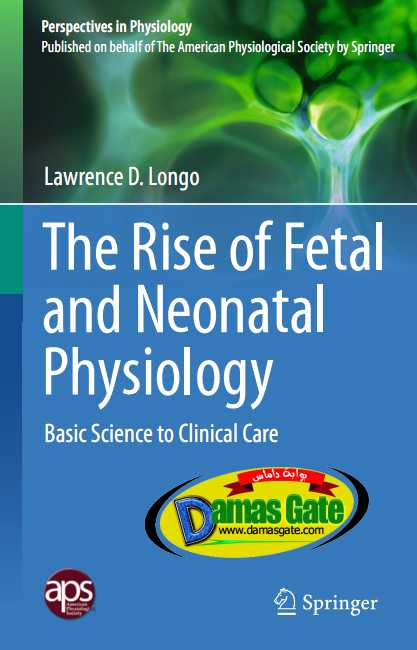The Rise of Fetal and Neonatal Physiology: Basic Science to Clinical Care - Perspectives in Physiology

Pref ace
History is always best written generations after the event, when cloud, fact and memory
have all fused into what can be accepted as truth, whether it be so or not” (Theodore Harold White 1961, p. 188)
It was in the autumn of 2008 that Charles Evans Wood, of the University of Florida, Gainesville,
chairman of the program committee of the Fetal and Neonatal Physiological Society, invited
me to present the Geoffrey S. Dawes Memorial Lecture at the 2009 meeting of that society. This lecture,
initiated in 1998 to honor Geoffrey Sharman Dawes (1918–1996), traditionally has been presented
by an established investigator who reviews some aspect of his or her studies during the
previous several decades. Rather than follow that formula, however, I developed
a different plan. As one interested in the history of ideas and the evolution of medicine,
for some time I had thought that it would be of value to document some of the major issues and
events associated with the genesis and development of the rather specialized field
of fetal and neonatal physiology. This was, in part, because of its relatively
brief history of less than a century, but also because of its enormous contributions
to understanding functional physiologic principles, and because of its concentration
on a vital and yet often overlooked aspect of biomedical science that has made a profound
impact on clinical medicine.
Among the seminal fi gures and major forces in developing the fi eld of fetal and neonatal
physiology was Geoffrey S. Dawes of the Nuffi eld Institute for Medical Research, University
of Oxford. Trained as a physician, he dedicated his career to understanding the physiologic
and pharmacologic basis of important clinical problems relating to the developing organism.
In a sense, this monograph could be viewed as a case study of the role of an individual
scientist, and many of the individuals he trained, in fostering, advancing,
and shaping a given field of research. Dawes’ scientific career covered
a period of 55 years (1941–1996), during which time he published over
220 papers. Included among these were a number of highly cited scientific
contributions, major reviews, introductions to symposia, and chapters
in books. As noted in the Foreword by
John Richard George Challis, critically,During the mid- to late-twentieth
century, study of the physiology of the developing fetus and newborn infant
evolved rapidly to become a major discipline in the biomedical sciences.
Initially of interest from a standpoint of function of the placenta and oxygenation of
the fetus, the field advanced to explore both
normal functional mechanisms as well as
pathophysiologic aspects of their regulation.
English -- 2013 -- ISBN: 1461479207 -- 428 pages -- PDF -- 9,1 MB
Download
*

Pref ace
History is always best written generations after the event, when cloud, fact and memory
have all fused into what can be accepted as truth, whether it be so or not” (Theodore Harold White 1961, p. 188)
It was in the autumn of 2008 that Charles Evans Wood, of the University of Florida, Gainesville,
chairman of the program committee of the Fetal and Neonatal Physiological Society, invited
me to present the Geoffrey S. Dawes Memorial Lecture at the 2009 meeting of that society. This lecture,
initiated in 1998 to honor Geoffrey Sharman Dawes (1918–1996), traditionally has been presented
by an established investigator who reviews some aspect of his or her studies during the
previous several decades. Rather than follow that formula, however, I developed
a different plan. As one interested in the history of ideas and the evolution of medicine,
for some time I had thought that it would be of value to document some of the major issues and
events associated with the genesis and development of the rather specialized field
of fetal and neonatal physiology. This was, in part, because of its relatively
brief history of less than a century, but also because of its enormous contributions
to understanding functional physiologic principles, and because of its concentration
on a vital and yet often overlooked aspect of biomedical science that has made a profound
impact on clinical medicine.
Among the seminal fi gures and major forces in developing the fi eld of fetal and neonatal
physiology was Geoffrey S. Dawes of the Nuffi eld Institute for Medical Research, University
of Oxford. Trained as a physician, he dedicated his career to understanding the physiologic
and pharmacologic basis of important clinical problems relating to the developing organism.
In a sense, this monograph could be viewed as a case study of the role of an individual
scientist, and many of the individuals he trained, in fostering, advancing,
and shaping a given field of research. Dawes’ scientific career covered
a period of 55 years (1941–1996), during which time he published over
220 papers. Included among these were a number of highly cited scientific
contributions, major reviews, introductions to symposia, and chapters
in books. As noted in the Foreword by
John Richard George Challis, critically,During the mid- to late-twentieth
century, study of the physiology of the developing fetus and newborn infant
evolved rapidly to become a major discipline in the biomedical sciences.
Initially of interest from a standpoint of function of the placenta and oxygenation of
the fetus, the field advanced to explore both
normal functional mechanisms as well as
pathophysiologic aspects of their regulation.
English -- 2013 -- ISBN: 1461479207 -- 428 pages -- PDF -- 9,1 MB
Download
*